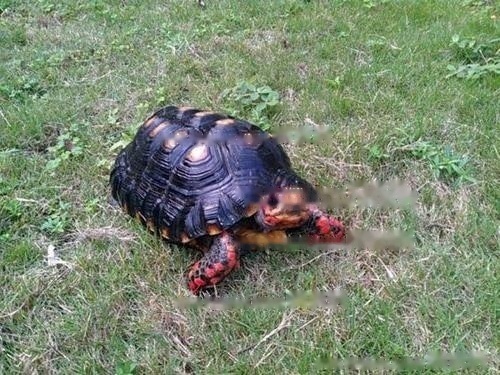The red-footed tortoise is a medium-sized species. Male red-footed tortoises have greater carapace length and weight than females, but not wider or taller (Moskovits, 1988). Like other tortoise species, male red-footed tortoises have sunken plastrons. When the red-footed tortoise is sexually mature, both males and females develop a distinctive mid-body contraction (sometimes call it a corset), giving the tortoise a distinct hourglass shape when viewed from above. This hourglass shape is more pronounced in males than in females. Adult males also have longer and wider tails than females.

Red-footed tortoise
red Legged tortoises go through a period of body color change during growth and development. The carapace of the hatchlings is light yellow or horny, and the dark brown or black markings will gradually increase as they grow older. The adult carapace is dark brown or dark brown, with a light yellow ring pattern in the center of each rib shield and vertebral shield. The large scales on the legs and tail vary in color from yellow to dark cherry red, with the brightest color usually seen in adult males. The color of the large scales on the head ranges from pale yellow to bright red (Legler, 1963). Red-footed tortoises vary considerably in their body color range, so no one can accurately describe each individual.
A brightly colored tropical tortoise. Easy to raise, it is ideal for beginners in raising tortoises.
Geographical Distribution:
Islands of South America and the Caribbean; Amazon Basin, including Paraguay, Suriname, Colombia, Guyana, Venezuela, Brazil, Ecuador ;
Wild Habitats: Ground habitats, forests, tree holes, fever caves.
Food : Field food herbivorous (vegetarian); fallen fruit (especially plums), mushrooms, vines, succulents, grasses, vegetables, flowers, carrion.
Main feed: Various fruits (eg: plum, peach, strawberry, apple with skin, kiwi, star fruit, papaya, mango, tomato, etc.) , carrots, mushrooms, beans, peas, grasses, vegetables, flowers, dark green leafy plants (eg: dandelion, mustard greens, kale, rutabaga, kale), box turtle and tortoise food, tortoise food
Oviparous eggs produce 2 - 4 litters per year of 5 - 15 eggs per litter, hatching period 4 months, mating age 4 - 5 years, mating period 7 - September.
While the red-footed tortoise is usually found in relatively dry grassland and forest areas, this species also occurs in moist forest environments. There is some disagreement about which habitat is their first choice. Walker (1989) asserted that red-footed tortoises prefer grasslands and dry forest areas, and probably only a few prefer rainforest habitats. Other authors, however, claim or suggest that moist forests are the preferred habitat (Legler, 1963) (Moskovits, 1988). Red-footed tortoises have been reported to be primarily herbivorous in the wild, but also eat small amounts of animal food such as carrion (Moskovits, 1985). Red-footed tortoises are very active after the rainy season when the breeding season begins. Male red-footed tortoises are involved in a fight, with male competitors trying to overturn their opponents. We noticed an interesting phenomenon, in almost every species of tortoise in which male fighting occurs, the males are usually larger than the females. In contrast, males are generally smaller than females in terrapin species, and male-to-male fighting does not occur. It has been suggested that breeds with male-fighting evolved larger males because larger males would have a higher chance of winning in this contest to mate with females, thereby passing on their large size to their males. offspring. Breeds with smaller males evolved because smaller males were quicker and able to mate with many females, thereby passing on their gene (Berry and Shine, 1980). In natural habitats, mating occurs after the rainy season, from July to September, with clutches ranging from 5-15 eggs (Medem, 1962). Red-footed tortoises, as well as many other species of tortoises, mature very slowly and do not reach sexual maturity after several years. This factor, coupled with relatively low egg laying numbers, makes red-footed tortoises vulnerable to overhunting. Due to overhunting, too many adult males and females are removed from the population, leaving only immature juveniles, and as a result, the population as a whole begins to decline. While the red-footed tortoise is not listed as endangered, it may become a reality in the near future if hunting rates and habitat loss continue at current levels. Conservation efforts include the establishment and protection of wildlife reserves and national parks where red-footed tortoises and other animals are protected from hunting (Walker, 1989).
![[Dog Training 5] The training method of pet dog dining etiquette](/static/img/12192/12192_1.jpg)




